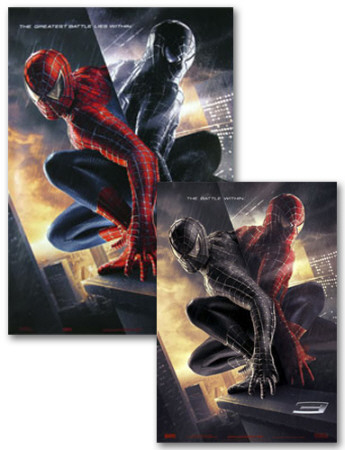About Spider-Man 3 Special Effects
About the Visual Effects
“The audience always demands new things, to be taken to new places,” says director Sam Raimi. “When it comes to visual effects, that means you either rely on existing technology and apply it in new ways or develop new technology to bring about these fantastic sights. You’re always asking yourself, ‘What haven’t I seen before?’ Well, if you haven’t seen it before, there’s probably no technology to bring it about. In almost every case, we had to develop the means to pull off the effects for Spider-Man™ 3.”
For visual effects supervisor Scott Stokdyk – the man charged with bringing the visual effects to the screen – those words were the beginning of a two-year process to develop the technology that would make Spider-Man™ 3 the most visually stunning film in the series so far. As great as the challenge to bring Sandman to the screen was for the practical effects departments, perhaps no group faced a greater hurdle than Stokdyk’s team.
“When we began the pre-production process, the computer programs had not yet been developed which could achieve the look of Sandman and his capabilities that Sam wanted to see,” recalls producer Grant Curtis. “However, Scott Stokdyk and his team created new technology to manipulate every piece of sand on our character. The existing technology allowed management of thousands of particles at once – but to animate Sandman the way Sam wanted to, we would have to be able to render billions of particles. In the end, the new software they wrote required ten man-years to code.”
A team of programming engineers, led by Douglas Bloom, Jonathan Cohen, and Chris Allen, stepped up to deliver the software that would give the animators the tool they needed to do their job.
Producer Avi Arad notes that before any work could begin, the animators first had to know what they were up against. “We had to understand how sand behaves. Only after we did that could we work out the mathematical equations to know how to manipulate it.”
Stokdyk saw from the very beginning that to bring Sandman to the screen would require his team to step up their game. “We knew from the start of this movie that we were facing a huge challenge from an effects and character animation perspective – sand,” says Stokdyk. “Sam wanted the on-screen sand to be controllable, but not magical. The sand had to flow in a very realistic fashion. We’ve all seen falling sand, so that had to sell as real. But the sand would also have to flow up and form into a human being.”
Stokdyk says that he and his team prepared for the challenge by first observing how sand moves in the real world. “One of the first things we did was to organize a sand shoot with Sam and Bill Pope, the director of photography,” Stokdyk continues. “We shot footage of sand every way we would need it – thrown up, thrown against blue screen, over black screen. John Frazier, the special effects supervisor, shot it out of an aero can at a stuntman. Anything we could imagine sand doing in the film, we shot.”
What they found was a new way to think about sand. “Sand has unique challenges in that it behaves sometimes like a solid – you’ll often see individual grains flying – and sometimes like a liquid – think of rolling sand dunes,” Stokdyk continues. “We knew that raw particle count was going to be our big challenge – not only from a technical standpoint, but from an artistic one, combining effects animation of sand flying around with character-driven animation.”
As Stokdyk and the effects animators were working out the “quantum mechanics” of the motion of sand, Spencer Cook, the animation supervisor on Spider-Man™ 3, began the process of designing the character. “Sandman is really an interesting challenge in that he requires such integration between character animation and effects animation,” he says. “The sand, and the way sand moves on his body, and the way he moves are all intimately tied together. Not only did we have to animate the character realistically and in line with Thomas’s performance, but all while chunks of sand are falling off the character.”
“There’s a character there, emoting, but it’s just a pile of sand,” says Stokdyk. “If we’ve pulled together enough grains of sand to make people feel something, then we’ve pulled it off.”
In the end, the artists were all extremely proud of their creation. “Sony Pictures Imageworks delivered on Spider-Man™ and Spider-Man™ 2, but for Spider-Man™ 3 it changed the industry standard,” says Curtis.
Sandman, of course, was not the only character that posed a considerable challenge for Cook; animating the black-suited Spider-Man required subtle changes to reflect the character’s more aggressive personality. “He’ll move a little quicker here and there, hunch his shoulders a little more, pull his elbows up a little higher when he’s stuck to a wall. We tried to find poses that the classic Spider-Man would not do – where the redsuited Spider-Man was graceful and elegant in his motions, black-suited Spider-Man is more blunt, rough, and reckless.”
In creating Venom, Stokdyk notes that the character has at least three distinct stages. First, of course, is the initial transformation, in which Topher Grace’s skin is pulled away from his body and tendrils of goo cross his face until they completely envelop him. “As he gets angrier, he turns into more of a monster, more of a beast,” Stokdyk notes. First, he becomes a kind of double for Spider-Man, played by Grace. By the very end of the film, he becomes an entirely CG character – the classic Venom from the comic books, with a menacing, unhinged jaw and full mouth of very sharp teeth.
Views: 171
